[First published in 2008. Scroll down for plain text.]
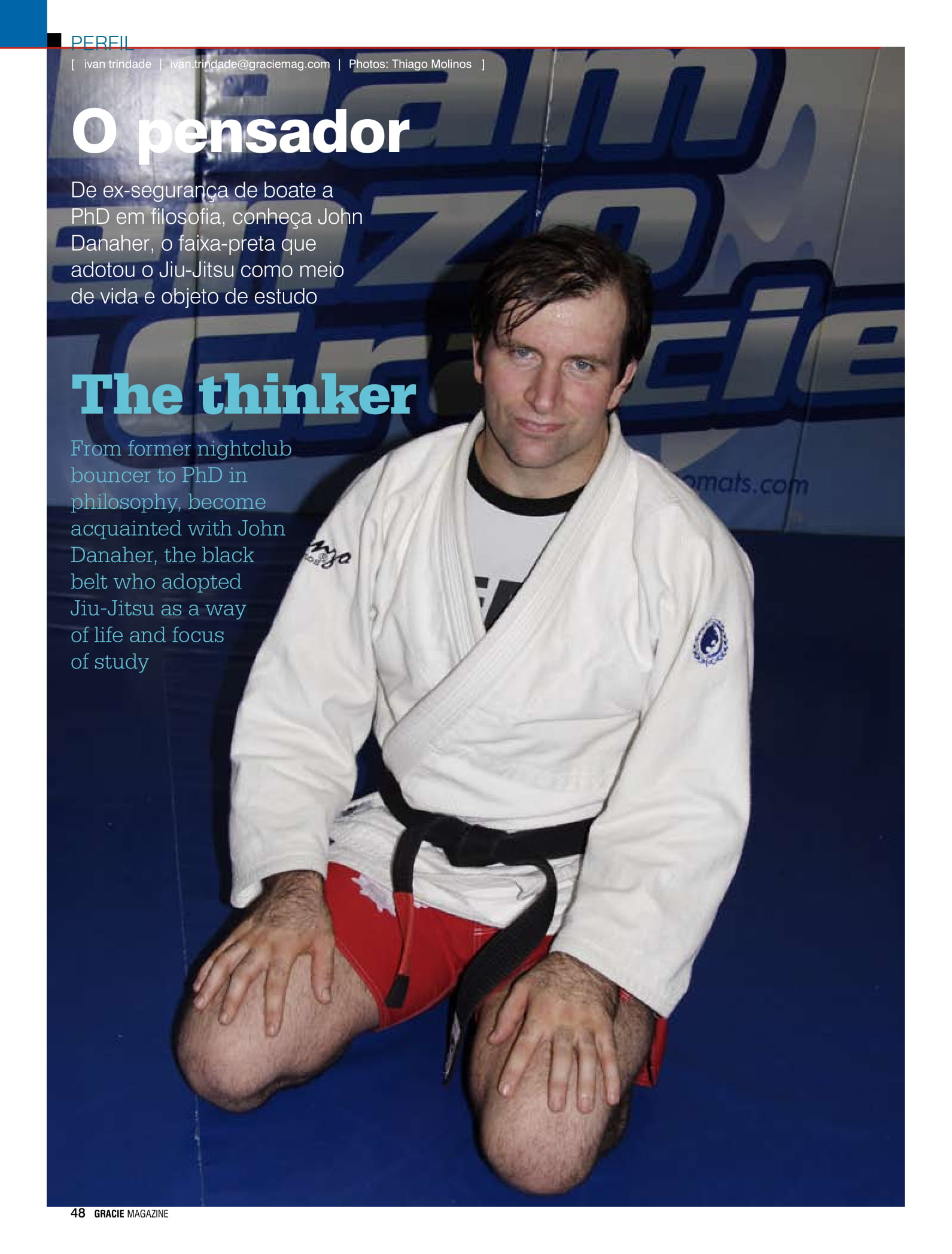
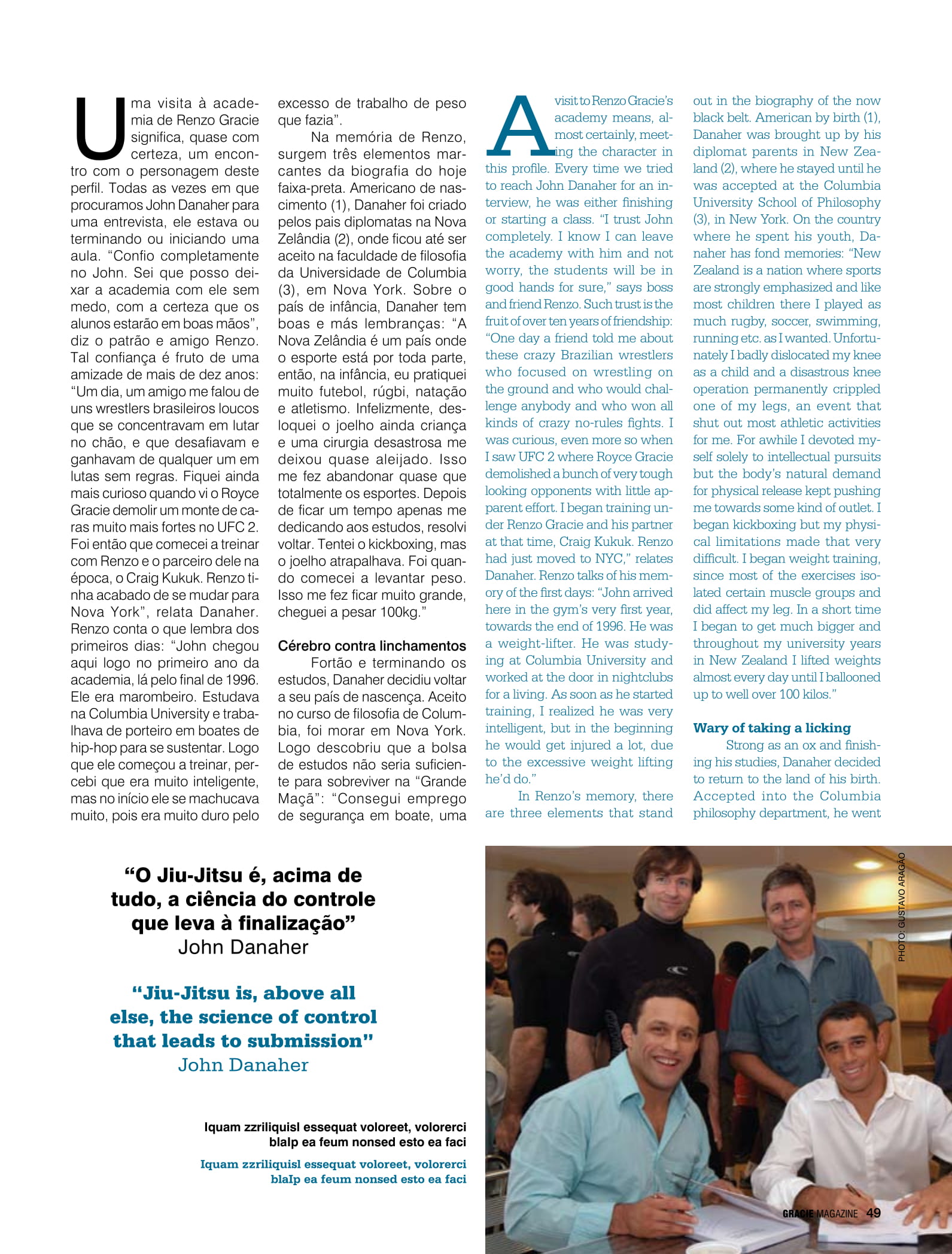
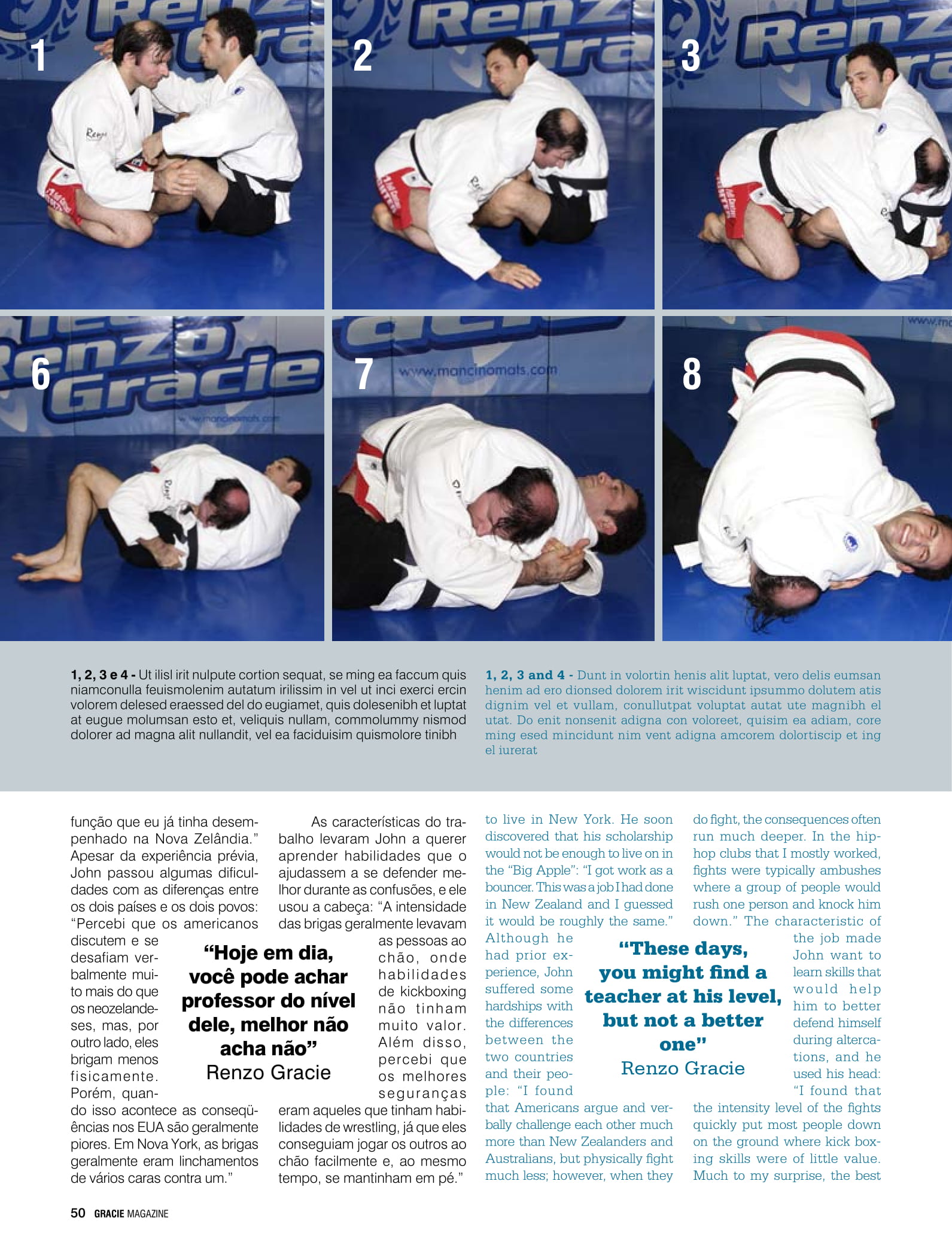
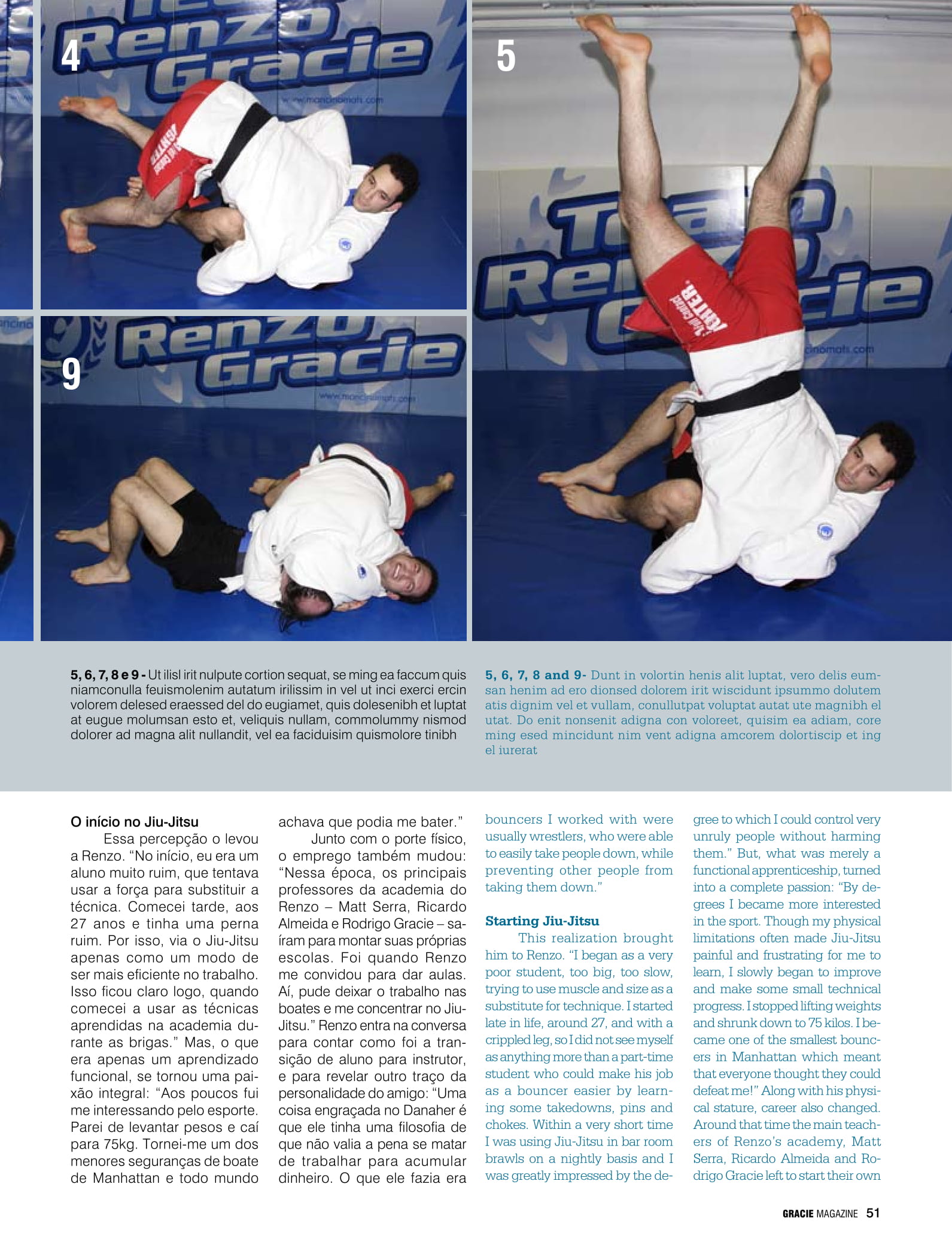
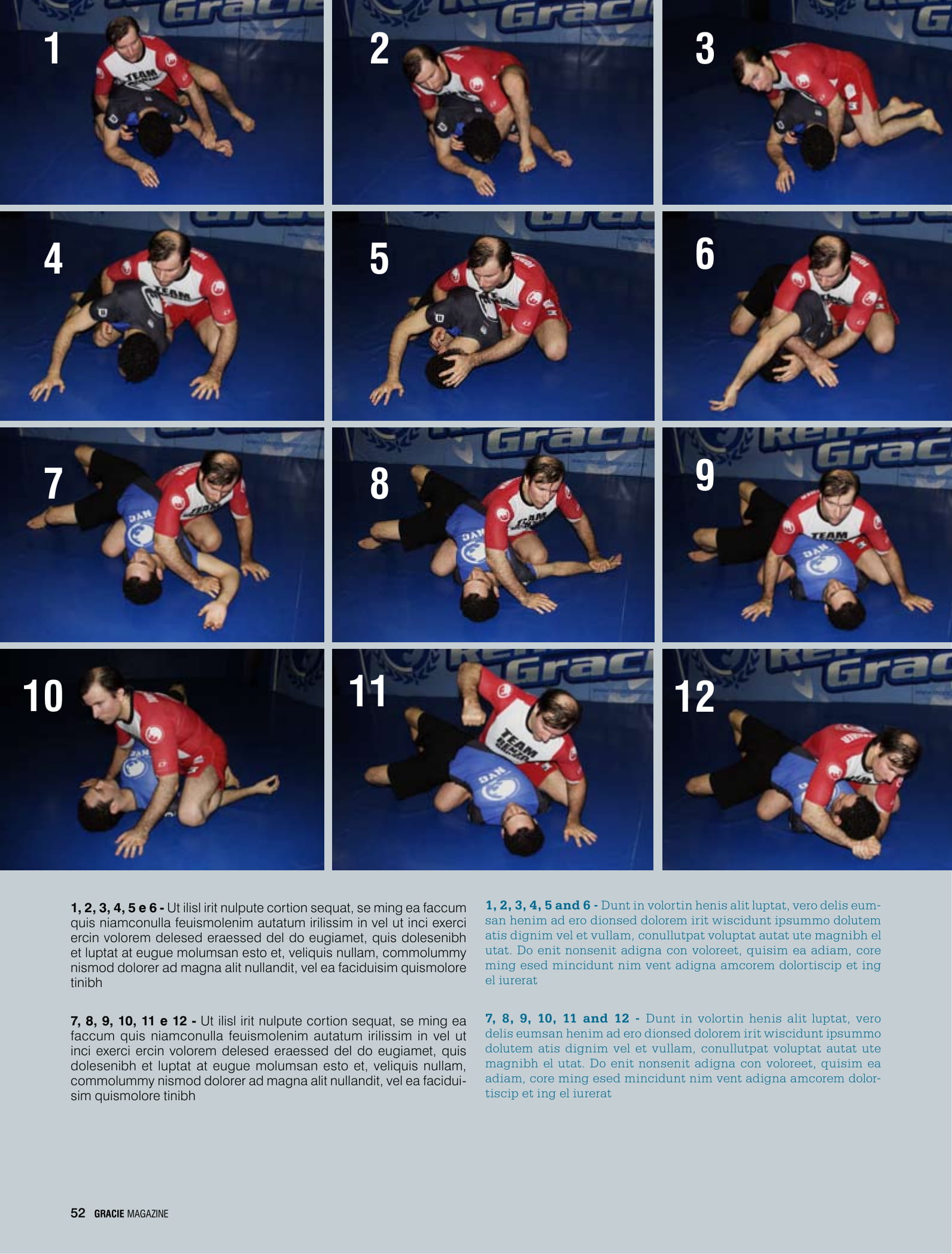
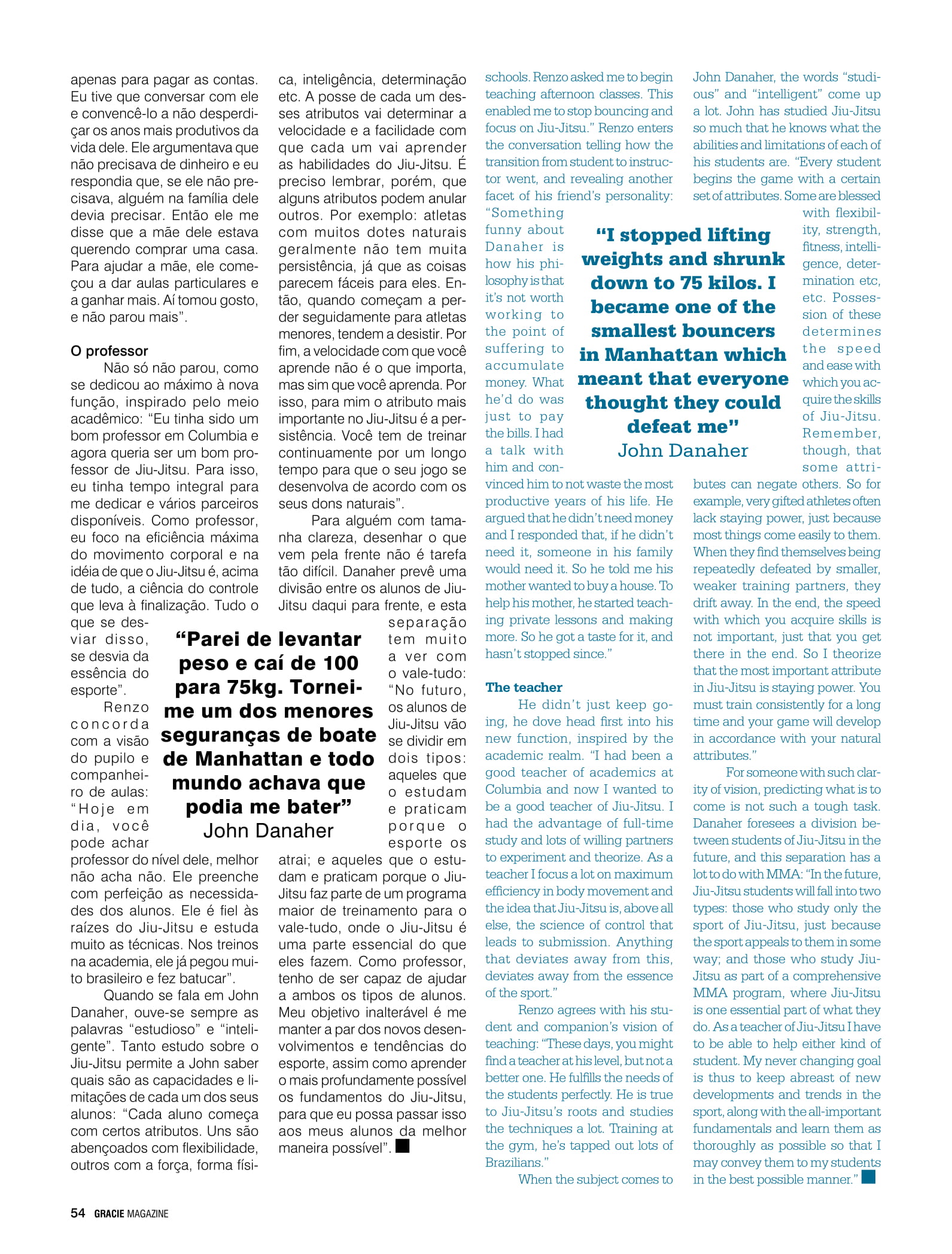
A visit to Renzo Gracie’s
academy means, almost
certainly, meeting
the character in
this profile. Every time we tried
to reach John Danaher for an interview,
he was either finishing
or starting a class. “I trust John
completely. I know I can leave
the academy with him and not
worry, the students will be in
good hands for sure,” says boss
and friend Renzo. Such trust is the
fruit of over ten years of friendship:
“One day a friend told me about
these crazy Brazilian wrestlers
who focused on wrestling on
the ground and who would challenge
anybody and who won all
kinds of crazy no-rules fights. I
was curious, even more so when
I saw UFC 2 where Royce Gracie
demolished a bunch of very tough
looking opponents with little apparent
effort. I began training under
Renzo Gracie and his partner
at that time, Craig Kukuk. Renzo
had just moved to NYC,” relates
Danaher. Renzo talks of his memory
of the first days: “John arrived
here in the gym’s very first year,
towards the end of 1996. He was
a weight-lifter. He was studying
at Columbia University and
worked at the door in nightclubs
for a living. As soon as he started
training, I realized he was very
intelligent, but in the beginning
he would get injured a lot, due
to the excessive weight lifting
he’d do.”
In Renzo’s memory, there
are three elements that stand
out in the biography of the now
black belt. American by birth (1),
Danaher was brought up by his
diplomat parents in New Zealand
(2), where he stayed until he
was accepted at the Columbia
University School of Philosophy
(3), in New York. On the country
where he spent his youth, Danaher
has fond memories: “New
Zealand is a nation where sports
are strongly emphasized and like
most children there I played as
much rugby, soccer, swimming,
running etc. as I wanted. Unfortunately
I badly dislocated my knee
as a child and a disastrous knee
operation permanently crippled
one of my legs, an event that
shut out most athletic activities
for me. For awhile I devoted myself
solely to intellectual pursuits
but the body’s natural demand
for physical release kept pushing
me towards some kind of outlet. I
began kickboxing but my physical
limitations made that very
difficult. I began weight training,
since most of the exercises isolated
certain muscle groups and
did affect my leg. In a short time
I began to get much bigger and
throughout my university years
in New Zealand I lifted weights
almost every day until I ballooned
up to well over 100 kilos.”
Wary of taking a licking
Strong as an ox and finishing
his studies, Danaher decided
to return to the land of his birth.
Accepted into the Columbia
philosophy department, he went
to live in New York. He soon
discovered that his scholarship
would not be enough to live on in
the “Big Apple”: “I got work as a
bouncer. This was a job I had done
in New Zealand and I guessed
it would be roughly the same.”
Although he
had prior experience,
John
suffered some
hardships with
the differences
between the
two countries
and their people:
“I found
that Americans argue and verbally
challenge each other much
more than New Zealanders and
Australians, but physically fight
much less; however, when they
do fight, the consequences often
run much deeper. In the hiphop
clubs that I mostly worked,
fights were typically ambushes
where a group of people would
rush one person and knock him
down.” The characteristic of
the job made
John want to
learn skills that
would he l p
him to better
defend himself
during altercations,
and he
used his head:
“I found that
the intensity level of the fights
quickly put most people down
on the ground where kick boxing
skills were of little value.
Much to my surprise, the best
bouncers I worked with were
usually wrestlers, who were able
to easily take people down, while
preventing other people from
taking them down.”

Starting Jiu-Jitsu
This realization brought
him to Renzo. “I began as a very
poor student, too big, too slow,
trying to use muscle and size as a
substitute for technique. I started
late in life, around 27, and with a
crippled leg, so I did not see myself
as anything more than a part-time
student who could make his job
as a bouncer easier by learning
some takedowns, pins and
chokes. Within a very short time
I was using Jiu-Jitsu in bar room
brawls on a nightly basis and I
was greatly impressed by the degree
to which I could control very
unruly people without harming
them.” But, what was merely a
functional apprenticeship, turned
into a complete passion: “By degrees
I became more interested
in the sport. Though my physical
limitations often made Jiu-Jitsu
painful and frustrating for me to
learn, I slowly began to improve
and make some small technical
progress. I stopped lifting weights
and shrunk down to 75 kilos. I became
one of the smallest bouncers
in Manhattan which meant
that everyone thought they could
defeat me!” Along with his physical
stature, career also changed.
Around that time the main teachers
of Renzo’s academy, Matt
Serra, Ricardo Almeida and Rodrigo
Gracie left to start their own
schools. Renzo asked me to begin
teaching afternoon classes. This
enabled me to stop bouncing and
focus on Jiu-Jitsu.” Renzo enters
the conversation telling how the
transition from student to instructor
went, and revealing another
facet of his friend’s personality:
“Something
funny about
Danaher is
how his philosophy
is that
it’s not worth
working to
the point of
suffering to
accumulate
money. What
he’d do was
just to pay
the bills. I had
a talk with
him and convinced
him to not waste the most
productive years of his life. He
argued that he didn’t need money
and I responded that, if he didn’t
need it, someone in his family
would need it. So he told me his
mother wanted to buy a house. To
help his mother, he started teaching
private lessons and making
more. So he got a taste for it, and
hasn’t stopped since.”
The teacher
He didn’t just keep going,
he dove head first into his
new function, inspired by the
academic realm. “I had been a
good teacher of academics at
Columbia and now I wanted to
be a good teacher of Jiu-Jitsu. I
had the advantage of full-time
study and lots of willing partners
to experiment and theorize. As a
teacher I focus a lot on maximum
efficiency in body movement and
the idea that Jiu-Jitsu is, above all
else, the science of control that
leads to submission. Anything
that deviates away from this,
deviates away from the essence
of the sport.”
Renzo agrees with his student
and companion’s vision of
teaching: “These days, you might
find a teacher at his level, but not a
better one. He fulfills the needs of
the students perfectly. He is true
to Jiu-Jitsu’s roots and studies
the techniques a lot. Training at
the gym, he’s tapped out lots of
Brazilians.”
When the subject comes to
John Danaher, the words “studious”
and “intelligent” come up
a lot. John has studied Jiu-Jitsu
so much that he knows what the
abilities and limitations of each of
his students are. “Every student
begins the game with a certain
set of attributes. Some are blessed
with flexibility,
strength,
fitness, intelligence,
determination
etc,
etc. Possession
of these
determines
the speed
and ease with
which you acquire
the skills
of Jiu-Jitsu.
Remember,
though, that
some attributes
can negate others. So for
example, very gifted athletes often
lack staying power, just because
most things come easily to them.
When they find themselves being
repeatedly defeated by smaller,
weaker training partners, they
drift away. In the end, the speed
with which you acquire skills is
not important, just that you get
there in the end. So I theorize
that the most important attribute
in Jiu-Jitsu is staying power. You
must train consistently for a long
time and your game will develop
in accordance with your natural
attributes.”
For someone with such clarity
of vision, predicting what is to
come is not such a tough task.
Danaher foresees a division between
students of Jiu-Jitsu in the
future, and this separation has a
lot to do with MMA: “In the future,
Jiu-Jitsu students will fall into two
types: those who study only the
sport of Jiu-Jitsu, just because
the sport appeals to them in some
way; and those who study Jiu-
Jitsu as part of a comprehensive
MMA program, where Jiu-Jitsu
is one essential part of what they
do. As a teacher of Jiu-Jitsu I have
to be able to help either kind of
student. My never changing goal
is thus to keep abreast of new
developments and trends in the
sport, along with the all-important
fundamentals and learn them as
thoroughly as possible so that I
may convey them to my students
in the best possible manner.”
